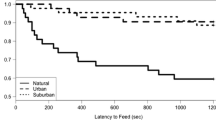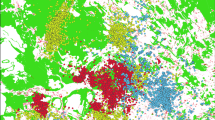Abstract
Foraging herbivores have to trade-off between energy requirements and predator avoidance. We aimed to study the relative roles of these factors in beavers (Castor canadensis) when foraging on land. We hypothesized that beavers were able to assess the risk of predation by using two main cues: the distance from the water and the presence or absence of predator odors. First, we studied the food selection of beavers in relation to distance from the water in natural settings. The transects were made at beaver ponds, and the diameter, species, and distance from the shore of intact and beaver-cut trees were recorded. Secondly, we placed rows of aspen sticks (Populus tremula) perpendicular to the shore around beaver ponds, and treated each row with a neutral, alien, or wolf odor. We found that aspen, downy birch (Betula pubescens), and speckled alder (Alnus incana) were the preferred tree species. More of these species were cut close to the shore, and cut trees were smaller further away from the shore, except in the case of aspen. In the experiment, most of the aspen sticks were taken close to the shore. As predicted, beavers took less aspen sticks in rows treated with wolf odor than water. As the predator odor did not affect the foraging distance from the shore, it is likely that our observation that foraging was the most intense close to shore is due to energetic constraints. However, predation risk probably affects the decision whether to forage on the land in the first place.







Similar content being viewed by others
References
Aleksiuk M (1970) The seasonal food regime of arctic beavers. Ecology 51:264–270
Apfelbach R, Blanchard CD, Blanchard RJ, Hayes RA, McGregor IS (2005) The effects of predator odors in mammalian prey species: a review of field and laboratory studies. Neurosci Biobehav Rev 29:1123–1144
Basey JM, Jenkins SH (1995) Influences of predation risk and energy maximization on food selection by beavers (Castor canadensis). Can J Zool 73:2197–2208
Baskin LM (2011) Predators as determinants of beaver alertness and shelter-making behavior. In: Sjöberg G, Ball JP (eds) Restoring the European beaver: 50 years of experience. Pensoft, Sofia, pp 271–280
Bates D, Maechler M, Bolker B (2011) lme4: linear mixed-effects models using S4 classes, R package version 0.999375-42, http://CRAN.R-project.org/package=lme4
Beier P, Barrett RH (1987) Beaver habitat use and impact in Truckee River basin, California. J. Wildl Manage 51:794–799
Belovsky GE (1984) Summer diet optimization by beaver. Am Midl Nat 111:209–222
Busher PE (1996) Food caching behavior of beavers (Castor canadensis): selection and use of woody species. Am Midl Nat 135:343–348
Byers CR, Steinhorst RK, Krausman PR (1984) Clarification of a technique for analysis of utilization-availability data. J Wildl Manag 48:1050–1053
Chamaillé-Jammes S, Malcuit H, Le Saout S, Martin JL (2013) Innate threat-sensitive foraging: black-tailed deer remain more fearful of wolf than of the less dangerous black bear even after 100 years of wolf absence. Oecologia 174:1151–1158
Charnov EL (1976) Optimal foraging, the marginal value theorem. Theor Pop Biol 9:129–136
Chavez AS, Gese EM (2005) Food habits of wolves in relation to livestock depredations in northwestern Minnesota. Am Midl Nat 154:253–263
Collen P, Gibson RJ (2000) The general ecology of beavers (Castor spp.), as related to their influence on stream ecosystems and riparian habitats, and the subsequent effects on fish—a review. Rev Fish Biol Fish 10:439–461
Cooper WE (2000) Tradeoffs between predation risk and feeding in a lizard, the broad-headed skink (Eumeces laticeps). Behaviour 137:1175–1189
Cowlishaw GUY (1997) Trade-offs between foraging and predation risk determine habitat use in a desert baboon population. Anim Behav 53:667–686
Creel S, Christianson D (2008) Relationships between direct predation and risk effects. Trends Ecol Evol 23:194–201
Curio E (2012) The ethology of predation, vol 7. Springer Science and Business Media, Berlin
Danilov P, Kanshiev V, Fyodorov F (2011) Characteristics of North American and Eurasian beaver ecology in Karelia. In: Sjöberg G, Ball JP (eds) Restoring the European beaver: 50 years of experience. Pensoft, Sofia, pp 27–38
Development Core Team R (2015) R: a language and environment for statistical computing. R Foundation for Statistical Computing, Vienna
Doucet CM, Fryxell JM (1993) The effect of nutritional quality on forage preference by beavers. Oikos 67:201–208
Doucet CM, Walton RA, Fryxell JM (1994) Perceptual cues used by beavers foraging on woody plants. Anim Behav 47:1482–1484
Eccard JA, Pusenius J, Sundell J, Halle S, Ylönen H (2008) Foraging patterns of voles at heterogeneous avian and uniform mustelid predation risk. Oecologia 157:725–734
Engelhart A, Müller-Schwarze D (1995) Responses of beaver (Castor canadensis Kuhl) to predator chemicals. J Chem Ecol 21:1349–1364
Erome G (1983) Le castor dans la vallée du Rhône. Son écologie, sa distribution. Bièvre 5:177–195
Fendt M (2006) Exposure to urine of canids and felids, but not of herbivores, induces defensive behavior in laboratory rats. J Chem Ecol 32:2617–2627
Fortin D, Boyce MS, Merrill EH, Fryxell JM (2004) Foraging costs of vigilance in large mammalian herbivores. Oikos 107:172–180
Fryxell JM, Doucet CM (1991) Provisioning time and central-place foraging in beavers. Can J Zool 69:1308–1313
Fryxell JM, Vamosi SM, Walton RA, Doucet CM (1994) Retention time and the functional response of beavers. Oikos 71:207–214
Gallant D, Bérubé CH, Tremblay E, Vasseur L (2004) An extensive study of the foraging ecology of beavers (Castor canadensis) in relation to habitat quality. Can J Zool 82:922–933
Gorshkov D, Gorshkov Y (2011) Feeding strategy of beavers in Tatarstan Republic. In: Sjöberg G, Ball JP (eds) Restoring the European beaver: 50 years of experience. Pensoft, Sofia, pp 149–161
Haarberg O, Rosell F (2006) Selective foraging on woody plant species by the Eurasian beaver (Castor fiber) in Telemark, Norway. J Zool 270:201–208
Hall JG (1960) Willow and aspen in the ecology of beaver on Sagehen Creek, California. Ecology 41:484–494
Herman CS, Valone TJ (2000) The effect of mammalian predator scent on the foraging behavior of Dipodomys merriami. Oikos 91:139–145
Holmes WG (1984) Predation risk and foraging behavior of the hoary marmot in Alaska. Behav Ecol Sociobiol 15:293–301
Hyvönen T, Nummi P (2008) Habitat dynamics of beaver Castor canadensis at two spatial scales. Wildl Biol 14:302–308
Jenkins SH (1975) Food selection by beavers. Oecologia 21:157–173
Jenkins SH (1979) Seasonal and year-to-year differences in food selection by beavers. Oecologia 44:112–116
Jenkins SH (1980) A size-distance relation in food selection by beavers. Ecology 61:740–746
Johnston CA, Naiman RJ (1990) Browse selection by beaver: effects on riparian forest composition. Can J For Res 20:1036–1043
Kabbaj M, Devine DP, Savage VR, Akil H (2000) Neurobiological correlates of individual differences in novelty-seeking behavior in the rat: differential expression of stress-related molecules. J Neurosci 20:6983–6988
Kotler BP, Brown JS, Hasson O (1991) Factors affecting gerbil foraging behavior and rates of owl predation. Ecology 72:2249–2260
Kuijper DP, Verwijmeren M, Churski M, Zbyryt A, Schmidt K, Jędrzejewska B, Smit C (2014) What cues do ungulates use to assess predation risk in dense temperate forests? PLoS One 9:e84607
Lahti S, Helminen M (1974) The beaver Castor fiber (L.) and Castor canadensis (Kuhl) in Finland. Act Theriol 19:177–189
Langerhans RB (2007) Evolutionary consequences of predation: avoidance, escape, reproduction, and diversification. In: Elewa AMT (ed) Predation in organisms. Springer, Berlin, pp 177–220
Lima SL (1998) Nonlethal effects in the ecology of predator-prey interactions. Bioscience 48:25–34
Lima SL, Valone TJ, Caraco T (1985) Foraging-efficiency-predation-risk trade-off in the grey squirrel. Anim Behav 33:155–165
McGinley MA, Whitham TG (1985) Central place foraging by beavers (Castor canadensis): a test of foraging predictions and the impact of selective feeding on the growth form of cottonwoods (Populus fremontii). Oecologia 66:558–562
Müller-Schwarze D (2011) The beaver: its life and impact. Cornell University Press, Ithaca
Müller-Schwarze D, Sun L (2003) The beaver: natural history of a wetlands engineer. Cornell University Press, Ithaca
Neu CW, Byers CR, Peek JM (1974) A technique for analysis of utilization-availability data. J Wildl Manag 38:541–545
Newman JA, Caraco T (1987) Foraging, predation hazard and patch use in grey squirrels. Anim Behav 35:1804–1813
Northcott TH (1971) Feeding habits of beaver in Newfoundland. Oikos 22:407–410
Olsson O, Brown JS, Helf KL (2008) A guide to central place effects in foraging. Theor Pop Biol 74:22–33
Orians GH, Pearson NE (1979) On the theory of central place foraging. In: Horn DJ, Stairs GR, Mitchell RD (eds) Analysis of ecological systems. Ohio University Press, Athens, pp 155–177
Orrock JL, Danielson BJ, Brinkerhoff RJ (2004) Rodent foraging is affected by indirect, but not by direct, cues of predation risk. Behav Ecol 15:433–437
Pinkowski B (1983) Foraging behavior of beavers (Castor canadensis) in North Dakota. J Mamm 64:312–314
Pitcher TJ, Lang SH, Turner JA (1988) A risk-balancing trade off between foraging rewards and predation hazard in a shoaling fish. Behav Ecol Sociobiol 22:225–228
Potvin F, Breton L, Pilon C, Macquart M (1992) Impact of an experimental wolf reduction on beaver in Papineau-Labelle Reserve, Quebec. Can J Zool 70:180–183
Raffel TR, Smith N, Cortright C, Gatz AJ (2009) Central place foraging by beavers (Castor canadensis) in a complex lake habitat. Am Midl Nat 162:62–73
Ripple WJ, Beschta RL (2004) Wolves and the ecology of fear: can predation risk structure ecosystems? Bioscience 54:755–766
Rosell F (2001) Effectiveness of predator odors as gray squirrel repellents. Can J Zool 79:1719–1723
Rosell F, Czech A (2000) Responses of foraging Eurasian beavers Castor fiber to predator odours. Wildl Biol 6:13–21
Rosell F, Sanda J (2006) Potential risks of olfactory signaling: the effect of predators on scent marking by beavers. Behav Ecol 17:897–904
Schoener TW (1979) Generality of the size-distance relation in models of optimal feeding. Am Nat 114:902–914
Scrimgeour GJ, Culp JM (1994) Foraging and evading predators: the effect of predator species on a behavioural trade-off by a lotic mayfly. Oikos 69:71–79
Severud WJ, Belant JL, Bruggink JG, Windels SK (2011) Predator cues reduce American beaver use of foraging trails. Human-Wildl Interac 5:296–305
Smith DW, Trauba DR, Anderson RK, Peterson RO (1994) Black bear predation on beavers on an island in Lake Superior. Am Midl Nat 132:248–255
Stankowich T, Blumstein DT (2005) Fear in animals: a meta-analysis and review of risk assessment. Proc R Soc Lond B Biol Sci 272:2627–2634
Suhonen J (1993) Predation risk influences the use of foraging sites by tits. Ecology 74:1197–1203
Sullivan TP, Crump DR, Sullivan DS (1988a) Use of predator odors as repellents to reduce feeding damage by herbivores: IV. Northern pocket gophers (Thomomys talpoides). J Chem Ecol 14:379–389
Sullivan TP, Crump DR, Sullivan DS (1988b) Use of predator odors as repellents to reduce feeding damage by herbivores: III. Montane and meadow voles (Microtus montanus and Microtus pennsylvanicus). J Chem Ecol 14:363–377
Sun L, Müller-Schwarze D (1998) Beaver response to recurrent alien scents: scent fence or scent match? Anim Behav 55:1529–1536
Svendsen GE (1980) Seasonal change in feeding patterns of beaver in southeastern Ohio. J Wildl Manag 44:285–290
Thorson JM, Morgan RA, Brown JS, Norman JE (1998) Direct and indirect cues of predatory risk and patch use by fox squirrels and thirteen-lined ground squirrels. Behav Ecol 9:151–157
Vanha-Majamaa I, Lilja S, Ryömä R et al (2007) Rehabilitating boreal forest structure and species composition in Finland through logging, dead wood creation and fire: the EVO experiment. For Ecol Manag 250:77–88
Acknowledgments
We thank Matthias Fellhauer and Aleksi Polojärvi for their help with field work, and the technical staff of the LBS for their logistic support. The study was funded by the Lammi Biological Station.
Author information
Authors and Affiliations
Corresponding author
Additional information
Communicated by: Teresa Abaigar Ancín
Rights and permissions
About this article
Cite this article
Salandre, J.A., Beil, R., Loehr, J.A. et al. Foraging decisions of North American beaver (Castor canadensis) are shaped by energy constraints and predation risk. Mamm Res 62, 229–239 (2017). https://doi.org/10.1007/s13364-017-0312-6
Received:
Accepted:
Published:
Issue Date:
DOI: https://doi.org/10.1007/s13364-017-0312-6




